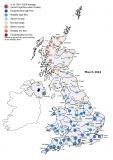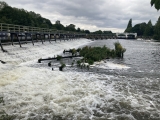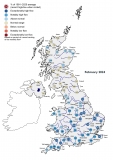Submitted by Steve Turner on
The UK Surface and Groundwater Archives Committee convened for its 34th annual meeting at CEH’s Wallingford Headquarters on Wednesday 8th March.
The Committee comprises representatives of organisations from across the UK involved in the measurement, management or use of hydrometric data. This year’s meeting was attended by the Scottish Environment Protection Agency, Environment Agency, Natural Resources Wales, Rivers Agency (NI), NERC, the British Hydrological Society, Met Office, Canal and Rivers Trust, British Geological Survey, DEFRA, CIWEM and representatives from the UK water industry. Amongst the items discussed at this year’s meeting was a review of the activities of the NRFA over the last 12 months.
As normal the NRFA’s activities have included updating and ongoing maintenance of the nation’s central database for hydrometric data. Ensuring that the archive is up-to-date involves an intensive programme of year round work to quality control new data before it is added to the archive and make corrections and updates to existing data. The NRFA’s core daily mean flow dataset alone was subject to around 460,000 updates and changes in the last 12 months.
Other activities over the last year include a two-day liaison visit in October, visiting gauging stations in the East Midlands area of the Environment Agency. Such visits allow the NRFA’s Regional Representatives to update their knowledge of current equipment, processes and problems at each site, giving them a better understanding of how the data are measured. This information informs the quality control of data submitted to the archive and allows metadata updates to inform the user community of new and emerging issues which should be considered when analysing NRFA data.
NRFA staff also attended the 4th BHS International Symposium at Cranfield University, and the Flood Expo at the ExCel Centre, which allowed opportunities to engage with key stakeholders in consultancies, the water industry, public sector departments and the flood and coastal risk community. At the end of March, NRFA staff will also attend the Flood & Coast 2017 exhibition in Telford, which will provide further opportunities for community engagement.
2016/2017 saw the release of the version 4 of the WINFAP-FEH data files for use in flood estimation. In addition to the core peak flow data, a swathe of metadata updates have been included, which relate to FEH catchment descriptors and suitabilities, ratings and datums, missing and rejected data and station descriptions. This additional information about the gauging stations is provided to allow hydrologists to make informed judgements regarding use of the data. This version of the files reflects the first major update to the peak flow database since stewardship was passed to the NRFA (with previous updates provided under the HiFlows-UK initiative).
The NRFA website remains very popular and has seen further increases in activity. Over 2016, there were over 36,000 downloads of river flow, spatial and metadata and a total of 671,834 page views by 52,313 users across all pages on the NRFA website.
The National Hydrological Monitoring Programme (NHMP), operated jointly by the Centre for Ecology & Hydrology and British Geological Survey has continued to publish the monthly Hydrological Summaries for the UK and have released two major publications on the 2015/2016 Winter Flooding in the UK. One year on from Storm Desmond (5th December) the NHMP report was released and brings together both river flow and meteorological data in an analysis of the events that led to extensive river flooding in northern England, Scotland, Northern Ireland and parts of Wales over a three month period. Further to the release of the Winter Floods 2015/2016 report, the NHMP’s open access paper was published in the journal Weather alongside two further papers which describe the meteorological events (McCarthy et al, 2016) and the meteorological records broken (Burt, 2016). Together this special issue aims to provide a comprehensive overview of the exceptional meteorological and hydrological conditions and their impacts in the winter of 2015/2016.
Looking forward, Isabella Tindall, Head of the NRFA commented, “2016/2017 has been a successful year for the NRFA, with a number of important outputs and updates to our services including the release of all daily flow data on our website. At this week’s UK Surface and Groundwater Archives Committee meeting our plans for the next 12 months were discussed. They include launching a number of new developments designed to further improve access to our data and help users to better understand the UK freshwater environment.”



